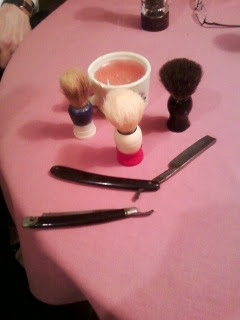ehhh...
Now, personally, my of ideas on what it takes for a traditional shave float somewhere between Peter Pan and Sweeney Todd, an interesting, if not savage combination. The blade is a bit different, a good deal of lather is involved, and in both cases something ends up stripped in the end...Without the gimmicks, the only things required are:
a razor
a brush
a cup
shave soap
a stand to set it all up
optional leather strap for sharpening
Sounds simple, right?
Wrong.
Refinement, as it turns out, takes some doing.
The razor:
Traditionally, men shaved with a straight razor, like the one which Johnny Depp so mercilessly brandishes. To keep them sharp, these require the most remarkable yet painfully simple tool. Plainer styles are comprised of a strip of leather. One step up is the more durable version made of a piece of leather wrapped around a block of wood, giving quite the variety to sharpening choices.
Yet, the correct manner of sharpening isn't as easy as one might presume. In order to appear sophisticated, take care to flip the razor with only the index finger and thumb. Otherwise, the hand should remain in the same position while sharpening the blade.
However, a straight blade and all its accessories certainly aren't for everyone. Even my Papa expressed his skepticism over putting that equivalent of a switchblade near his face, despite possession of it. Honestly, the razor type doesn't matter so much assuming the shaver keeps it classy. None of those two cent traveling affairs. Don't be this guy >>>

The brush/soap/cup:
The type of razor doesn't matter so much because this absolutely does. Seriously, if you feel the need to shirk something, well then, well... you're probably not a gentleman by my definition anyway, but don't let it be this section.
To begin with a brush, think of one like those women use to put blush on, except with a smaller handle. Still no visual? Here's my Papa's collection:
The one on the far left is made from badger (a softer feel), the middle is synthetic (a miserable excuse for a brush), and the darkest is a conglomeration of boar bristles (the coarsest and best of the three —depending on your taste). Do what you need to do, but don't put shaving cream on with your hands. In fact, forget shaving cream altogether. Get a small soup mug, shaving cup, or hipster coffee mug; they're all about the same size. This stuff goes inside:

Shave soap.
The color doesn't particularly matter. To my knowledge, there's definitely amber, almond, and lime to choose from if you stick with the Col. Conk brand, which runs about three bucks a bar. It's what my Papa uses. Whatever the brand, the most important thing is to ensure that it has glycerine in it. Before lotions were marketed for scent rather than softness, they were sure to say "glycerine" on the label. Glycerine is the ingredient that keeps skin soft after duress. On the Col. Conk label, it's smack dab in the middle of the very top of the sticker, a fact which, in my opinion, is no coincidence.
Now the apparatus that actually started the discussion of shaving technique between my Papa, Mimi, Daddy, and me was the dilemma of finding a stand.
Apparently, if the brush is set down with the quills pointed up, water becomes logged in the brush and deters the efficiency of the next shave. For this reason, my Papa searched for and purchased a stand. He found his complete with brush and cup in an antique store in Florida for 26 dollars. That kind of deal requires some waiting if quality is desired. However, if a second-hand brush finds itself in your possession, make sure that before use you sterilize it. This can be accomplished easily, by dipping the bristles into boiling water.
I hope this breakdown proves helpful; you're on your own deciphering aftershave....












































